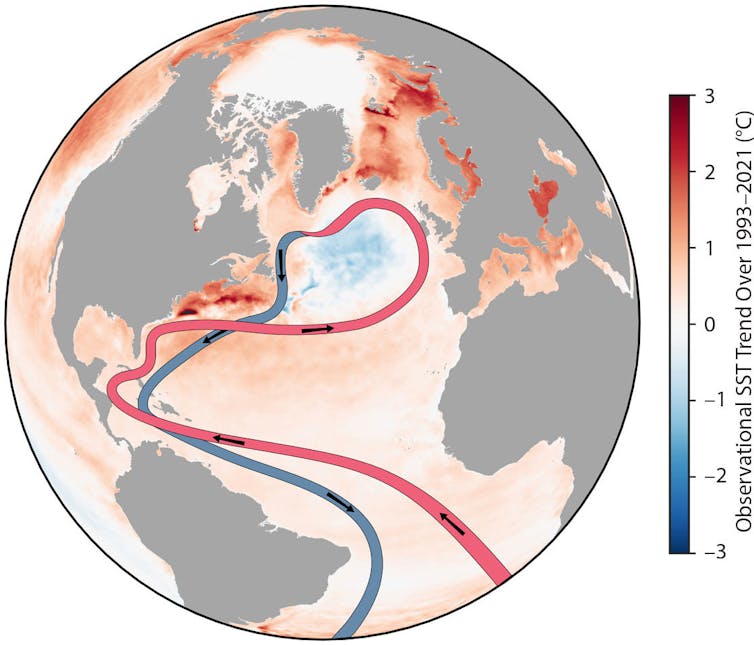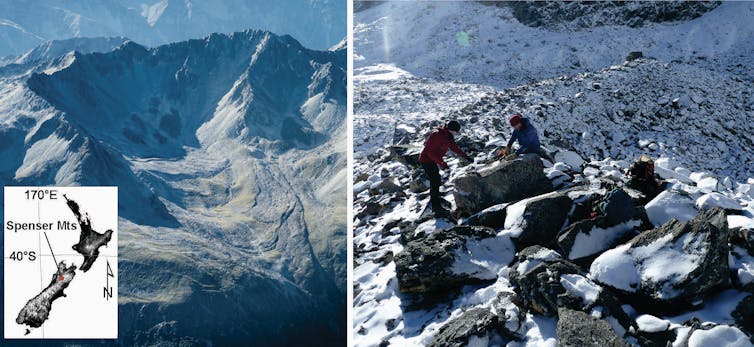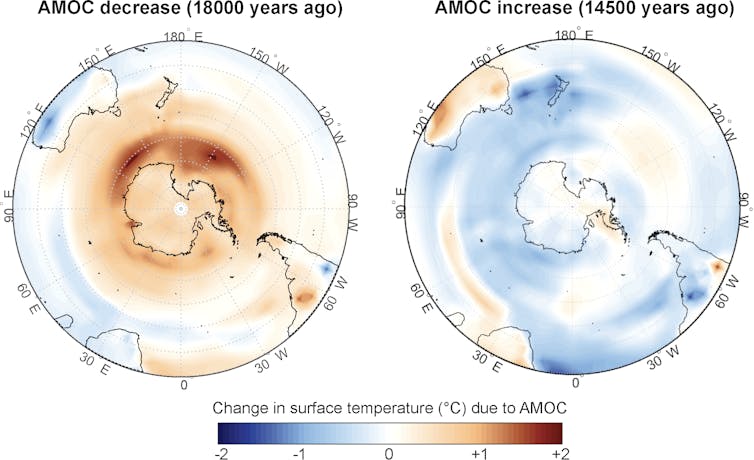
Recent assessments suggest the ocean current known as Atlantic Meridional Overturning Circulation (AMOC) is slowing down, with collapse a real possibility this century.
The AMOC is a globally important current in the Atlantic Ocean, where surface water moves northward as part of the Gulf Stream and transports warm water towards the Arctic. There it cools and sinks to return southward as a deep ocean current.

Collapse of the AMOC would have a devastating effect on climate in Europe. Temperatures in the UK and Scandinavia could drop by 5–15°C in a matter of decades.
However, because Earth’s climate system is interconnected, these impacts could have a global reach. Our new research shows past changes in AMOC have had significant impact on temperatures in New Zealand and across the southern hemisphere. These results imply that future collapse of AMOC may accelerate ongoing warming trends.
Lessons from the past
Between 20,000 and 10,000 years ago, Earth transitioned from peak ice-age conditions to a climate more like today’s. This interval featured rising global temperatures, melting ice sheets and climbing sea levels – all phenomena associated with present-day climate change.
Evidence from ice cores in Greenland and marine sediments in the North Atlantic suggests this natural warming event featured several abrupt changes associated with AMOC variability.
Using this interval as a natural experiment, we have undertaken research to learn more about how AMOC variability can affect climate in New Zealand.

To reconstruct how air temperature changed in New Zealand, we examined the past extent of mountain glaciers using evidence preserved in the landscape. Glaciers grow and shrink primarily in response to changing air temperature, which affects the annual balance of snowfall and snow or ice melt. As glaciers change in size, they deposit moraines (rock debris) in the landscape, which can persist for tens of thousands of years.

We combined these land-based observations with reconstructions of sea-surface temperature in the Tasman Sea, which we derived from microfossils (smaller than one millimetre in size) known as foraminifera. These microfossils come in a wide range of species and each has a preferred water temperature.
We quantified changes in foraminifera species in a core of marine sediment to trace how local temperature in the Tasman Sea has varied through time.
Global climate connections
Our results show that changes in air and sea-surface temperature followed a similar pattern in the New Zealand region as Earth warmed following the last ice age.
Warming began in both air and sea at about 18,000 years ago, followed by a cooling event at about 14,500 years ago – the Antarctic Cold Reversal. The timing of these changes matches past changes in the AMOC, as recorded in geological climate records from the North Atlantic region.
We examined computer simulations to test the physical connection between changes in the AMOC and New Zealand’s climate. These simulations used a physics-based climate model that captures atmospheric and ocean circulation and their interaction.

The model simulations support our geological evidence, showing air and sea surface temperatures in New Zealand respond sensitively to changes in AMOC intensity. When the AMOC weakens and Europe cools, New Zealand and the southern mid-latitudes undergo warming, and vice versa.
The models also indicate changes in the AMOC are transported rapidly, within decades, to New Zealand via shifting global wind systems. Changes in the AMOC disrupt the temperature gradient between the hemispheres, which is a key control on the strength of westerly wind belts in the southern hemisphere, between the latitudes of 40°S and 60°S where New Zealand is.
The westerly winds are important for New Zealand’s climate. They control the path of atmospheric storms and regional ocean currents.
Stronger winds over New Zealand bring regional cooling, as more storms track over the country and warm ocean currents are diverted away from the Tasman Sea into the south Pacific. In contrast, when the AMOC weakens, New Zealand has clearer skies and the Tasman Sea receives more tropical water masses, causing regional warming.
Future implications
Scientists have identified several “tipping points” in Earth’s climate system that may be triggered by human-caused climate change. Once these thresholds are crossed, the consequences cannot be easily undone.
Climbing greenhouse gas concentrations have raised air temperatures in New Zealand, and globally, by about 1.1°C since the late 19th century. Projections suggest New Zealand may end this century 1°C to 3°C warmer than now. However, these estimates do not include the potential impacts of a future AMOC collapse.
Our insights from the recent geological past show this AMOC tipping point has global reach, and could accelerate future warming in New Zealand.
Shaun Eaves receives funding from Royal Society of New Zealand Marsden Fund.
Andrew Mackintosh received funding from the Australian Research Council.
Joel Pedro received funding from the Carlsberg Chrono-Climate project and from the Australian government.
Helen Bostock does not work for, consult, own shares in or receive funding from any company or organisation that would benefit from this article, and has disclosed no relevant affiliations beyond their academic appointment.
This article was originally published on The Conversation. Read the original article.







